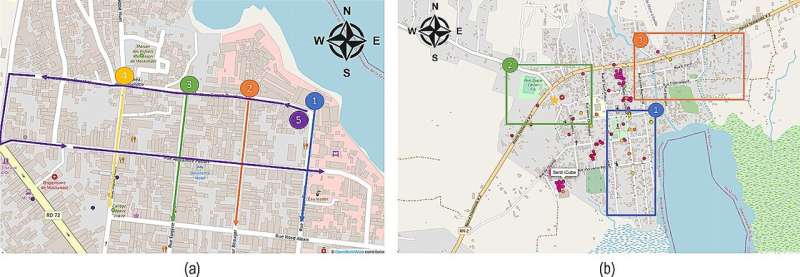This article has been reviewed according to Science X's editorial process and policies. Editors have highlighted the following attributes while ensuring the content's credibility:
fact-checked
peer-reviewed publication
trusted source
proofread
'Hybrid' disaster response shows how localization saves lives

In August 2021, an earthquake struck southwest Haiti, killing thousands of people and leaving more than half a million seeking help. Assessment of this disaster and its response can serve as a model for evaluating future disasters and making life-saving improvements, according to new research from a University of Notre Dame professor.
Tracy Kijewski-Correa, professor of engineering and global affairs and the William J. Pulte Director of the Pulte Institute for Global Development, part of Notre Dame's Keough School of Global Affairs, was the lead author for the study, published in the Bulletin of Earthquake Engineering.
"This research shows how the 2021 earthquake response in Haiti leveraged both local data collection and remote expertise on a large scale to quickly assess the damage and inform local decision makers," Kijewski-Correa said. "This hybrid approach shows how we can proactively embrace localization, empowering affected populations to play a significant role in generating solutions."
A hybrid disaster assessment approach
Kijewski-Correa, partners at GeoHazards International and students at Notre Dame helped coordinate the assessment, which she said unfolded amid travel constraints following the assassination of the Haitian president in July 2021. But going hybrid turned out to be an advantage: Small teams of Haitians used smartphones to share data and images with remote engineers.
This divide-and-conquer approach allowed responders to cover more ground more quickly than they could have with a conventional arrangement where engineers traveled to see damage sites firsthand, Kijewski-Correa said. And after any disaster, she said, gathering forensic information quickly, before debris shifts, is critical to determining what caused the damage.
Responders captured a representative sample of different building classes, including residential, educational, commercial, government and medical facilities, Kijewski-Correa said, facilitating a rapid assessment that assigned global damage ratings to more than 12,500 buildings.
Next, remote engineers used machine learning to analyze approximately 40,000 collected images and to identify some 200 homes that were built using traditional Haitian construction, Kijewski-Correa said. This, in turn, enabled data collectors in Haiti to conduct forensic documentation of 30 of these homes that performed well in the earthquake using another mobile app.
Leveraging traditional building techniques
The results were surprising, Kijewski-Correa said, Structures built using traditional Haitian construction fared better than those built with contemporary concrete and masonry approaches that experts had been touting in Haiti. She said the traditional homes' bracing scheme, which determines how buildings distribute and support the shock imparted by the earthquake, made all the difference.
"This was a crucial takeaway," Kijewski-Correa said. "Our data showed that traditional Haitian building techniques performed better than poorly implemented modern construction approaches we had recommended in the past. This has key implications for how we should build in Haiti, which has widespread informal construction, lacks mortgages or well-documented land rights, and experiences higher poverty rates.
"In this cultural context, these traditional Haitian approaches are more sustainable on every front," Kijewski-Correa said. "They use local materials and skill sets, are easier to repair when damaged, and have lower costs and smaller carbon footprints. We absolutely need to promote more of this approach."
Strengthening disaster resilience
Kijewski-Correa has shared takeaways from the earthquake assessment with researchers and humanitarian responders, including those at the World Bank, to help better support housing recovery after major disasters.
Kijewski-Correa co-authored the study with Eric Canales and Lamarre Presuma (graduates of the Keough School's Master of Global Affairs program), Notre Dame engineering graduate student Rachel Hamburger, and former Kellogg International Scholars Angelique Mbabazi and Meredith Lochhead.
The research is part of the Bulletin of Earthquake Engineering's special issue on remote data collection and analysis methods for disaster reconnaissance.
The study has implications for building more sustainably in low-income countries and for promoting localization in disaster assessments, Kijewski-Correa said.
"For years, organizations such as USAID have increasingly emphasized localization, or empowering local people to take a leadership role in programs," Kijewski-Correa said. "But there has been real reticence to extend that to life safety professions such as engineering because the assessments, if they're wrong, could have deadly consequences.
"Our model shows that you can have a best-of-both-worlds approach that pairs local knowledge and remote networks with highly specialized engineering expertise.
"This innovative hybrid approach to localization helped us respond more effectively and ultimately uncovered a key finding that will improve housing recovery recommendations by leveraging local insights. This model can help vulnerable communities worldwide more swiftly learn from disasters and ideally build back better to reduce future risk."
More information: Tracy Kijewski-Correa et al, A hybrid model for post-earthquake performance assessments in challenging contexts, Bulletin of Earthquake Engineering (2024). DOI: 10.1007/s10518-024-01927-8



















